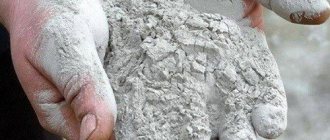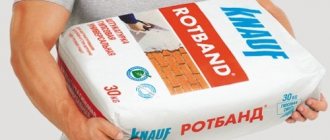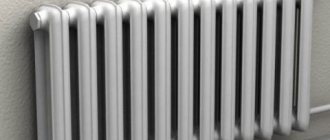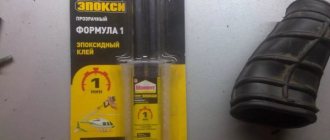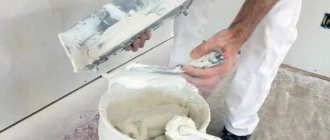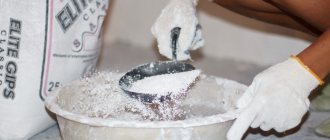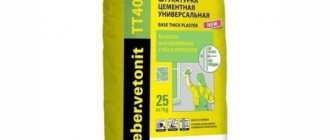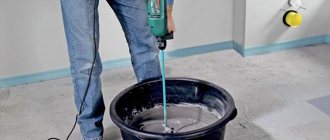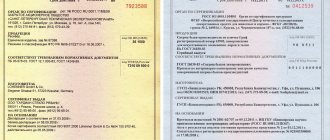08.04.2019
The putty is designed to level the base and increase the adhesion of building materials before finishing. Today on the building materials market you can find a huge number of different finishing putties. The most popular among them is the “Prospectors” putty. It is a glossy white mixture with a smooth texture. The putty of this brand has several series, each of which is designed to perform a specific type of work. Regardless of the scope of use, the characteristics of Prospector putty and adhesion indicators are quite high.
"Superfinish"
Composition of this building material:
- Binding polymers.
- Fine fractional fillers.
- Modifying and antiseptic impurities.
- Reinforcing fiber.
Putty Prospectors technical characteristics:
- Snow white color.
- Smooth surface.
- Layer thickness - up to 2 millimeters.
- Average fraction 60 microns
- Material adhesion - 0.5 MPa
- Drying - up to 4 hours. In this case, the thickness of the layer is equal to a millimeter, the temperature is 20±2 C, and the relative humidity is 60%.
- Putty prospectors consumption - from 0.3 kg/m2 to 0.5 kg/m2. In this case, the layer thickness is 0.3 millimeters.
- Frost resistance - 10 cycles.
- Shelf life: 1 year.
This putty is used to prepare the work surface for finishing. The mixture is suitable for indoor use and provides increased adhesion to any building material. It creates a smooth white layer on the working base that repels water and does not allow steam to pass through.
Execution of work
To apply the finishing putty solution you will need a spatula (with a double handle) or a trowel (50-80 centimeters). Apply the prepared mixture to a spatula (use a 10-centimeter spatula) and apply it to the surface so that the angle of contact of the solution with the base is 20-30 degrees and apply the putty diagonally with a uniform movement, this way we will achieve leveling of the surface vertically and horizontally. The dried surface is treated with sandpaper. For ease of sanding, you can use a mesh holder with a mesh or make your own block of wood to which the sandpaper will be attached. It is recommended to take sanding paper P120-P150. After sanding work, clean the base from dust. You can carry out painting or wallpapering work.
"Facade-finish"
This type of putty is intended for external and internal work in both high and optimal humidity. Excellent for both walls and ceilings, excellent for application on concrete and cement plaster.
Main characteristics:
- Snow white color.
- The mixing proportions are 0.32–0.40 liters of aqueous solution per kilogram.
- Layer thickness is 0.3–3.0 millimeters.
- Consumption 1.0 kg/m2 if the layer thickness is 1 millimeter.
- Service life is more than 3 hours.
- Frost resistance - more than 35 cycles.
The building material can be used in any construction. It should be noted that putty is not used on surfaces in contact with food and drinking water.
Application technique
For beginning craftsmen, the process of applying putty is very difficult. Here are recommendations to avoid problems when working:
- The drying speed of the mixture confuses slow puttyers. After all, the main principle of applying the starting composition of Prospectors is that the surface is puttied in one approach. The mixture is applied to the walls in parallel strips, so that one strip is layered on top of the previous one before it begins to set. Otherwise, the surface will not be smooth. The stripes go in any direction: vertically, horizontally or diagonally.
- The work is performed with at least two spatulas. A narrow 80 or 100 mm spatula is used to scoop up the solution from a container, and they work with wide spatulas. The width of the working spatula is selected depending on the surface area.
Work tool
It is important to achieve a uniform layer thickness. Without the skill, this is difficult to achieve.
The master does this reflexively, but the beginner will have to constantly monitor the angle of the spatula and the pressure applied. You need to “feel” the optimal combination of mixture thickness, angle of inclination and pressing force of the spatula. Too small an angle will result in a thick and uneven layer. Excessive pressure will cause the putty to squeeze out along the edges of the putty knife and create unwanted streaks. After the first layer is applied, the putty must dry completely. Typically, at normal humidity, this requires 24 hours. During this time, no excess moisture will remain in the thickness of the putty. Before the second application of the starting composition, the surface is primed again. This will prevent the second layer from drying unevenly and improve adhesion. The last layer before wallpapering is sanded with mesh No. 60 and No. 80.
Expert advice:
https://youtube.com/watch?v=videoseries
All tools used are cleaned with water immediately after completion of work. The dried mixture can only be removed mechanically, which can damage the spatulas.
Ready-to-use building mixtures have speeded up many works and made them less labor-intensive. And the simplicity of their preparation and application has allowed many home craftsmen today to independently carry out repairs at a professional level.
"Finish"
This putty is used for interior work. It is based on gypsum, and it itself is plastic and white in color.
Main characteristics:
- Snow white color.
- Mixing - 0.4–0.58 l/km.
- Layer thickness is 0.3–5 millimeters.
- Prospector putty consumption is 0.9 kg/m2, with a layer thickness of 1 mm.
- Viability - at least 60 minutes.
This type of putty is used to prepare the base for painting or wallpapering. Used for brick or concrete walls and ceilings. Can be used for plastering rooms followed by wet sanitary cleaning. Do not use on surfaces that are in direct contact with food and drinking water.
What's included
The basis of Starateli starting dry plaster is white cement, which expands the scope of application and speeds up the finishing time. Unlike plasters based on gray Portland cement, this mixture is light beige in color, so finishing begins immediately after the starting putty has dried. Judging by its composition, Starateli is more likely to be a dry plaster, but unlike other types, it is plastic, which is inherent in putties. This explains its versatility: Starateli plaster combines moisture resistance and leveling properties characteristic of gypsum putties.
Example of surfaces
An advantage in terms of saving money is wallpapering without additional puttying of the starting layer with finishing compounds.
The composition includes sifted and purified sand with a maximum fraction size of 0.4 mm.
In addition to ground clinker and gypsum, the putty formulation contains additives that improve elasticity, prevent shrinkage during drying and repel moisture. Prospector putty uses European polymer plasticizers and additives, “Wacker”, “Rhodia”.
Starter putty is a modified type, since marble flour, cellulose ethers and fine sand are added to it, which helps retain moisture and allows the putty to be applied in a layer of up to 1 cm.
"Finish KR"
This plastic composition has a polymer base and is intended for application in dry rooms.
Main characteristics:
- Snow white color.
- Mixing - 0.3–0.4 liters of water per kilogram.
- Layer thickness is 0.3–3 millimeters.
- Mixture consumption is 1.1 kg/m2 if the layer thickness is 1 millimeter.
- Operating time is more than a day.
It can be used to level interior walls and ceilings in dry rooms. It can also be used in rooms with wet sanitary cleaning. The result is a perfectly smooth white base that is perfect for painting. This type of putty is an ideal solution for plasterboard ceilings and walls.
How to make it yourself?
Another advantage of PVA-based putty is that it can be made at home. All ingredients can be easily purchased at hardware stores and household chemicals departments.
As a filling, you can use chalk with the addition of talc or baby powder, sawdust dust or ready-made dry gypsum putty. You can add CMC (dry wallpaper glue) or drying oil as a plasticizer. Sometimes household or liquid soap, washing powder and even casein paint are added to homemade putty.
The proportional ratio of ingredients in the putty is as follows:
- 10% PVA glue solution – 1 part;
- chalk or sawdust – 2.5 parts;
- plasticizers and other additives – 0.05 parts.
First, the dry ingredients are mixed, only then the solution is poured into the mixture of chalk and additives. If CMC is used, it must first be diluted. The resulting mixture should resemble sour cream in thickness. Too liquid may form sagging. The finished putty can be stored in a closed container for no more than 12 hours.
If you need very little putty, for example, to apply to a limited area or use for decorative purposes, then it is better to purchase a ready-made option. PVA putty is inexpensive and it is more profitable to purchase a ready-made one than to bother with its manufacture. For example, “Collection” brand putty costs about 100 rubles per 1.5 kg. Dry putty in bags can be even cheaper. The price is influenced solely by the presence of certain additives that improve the quality of the material.
To learn how to properly putty walls, see the following video.
"Finish Plus"
This is a plastic, waterproof composition with a polymer base that prepares the surface for painting or gluing thin and textured wallpaper.
Main characteristics:
- Snow white color.
- Smooth base.
- Layer thickness - up to 2 millimeters.
- The average fraction is 60 microns.
- The adhesion of building materials is 0.5 MPa.
- Drying time: up to 240 minutes. In this case, the thickness of the layer is a millimeter, the temperature is 20±2 C, and the relative humidity is 60%.
- Consumption from 0.3 kg/m2 to 0.5 kg/m2 if the layer thickness is 0.3 millimeters.
- Frost resistance - 10 cycles
- Shelf life - one year.
Used on cement or lime-cement surfaces and GLK ceilings. The mixture is not afraid of high humidity, so it is used in the preparation of any construction. Do not use on surfaces that come into direct contact with food and drinking water.
In order to correctly calculate putty miner consumption per m2, you must first decide what type of putty you will use. Most of it is spent on starting putty. If the base is crooked, the putty consumption increases. Knowing the consumption rates, everything is quite simple and easy to calculate. Decide on the working surface area, then, taking these parameters into account, make the necessary calculation.
Instructions for use
In order for the result to meet your expectations, you must strictly follow the instructions on the packaging. You should work with gloves, avoiding contact of the mixture with your skin:
- Prepare the surface: clean it of dust, paint, oil stains. The walls must be dry and durable.
- Surfaces with high absorbency must be coated with a primer.
- Prepare a clean container of suitable size.
- In accordance with the information on the packaging, measure the required amount of warm water (room temperature).
- Gradually pour the dry mixture into the water, stirring by hand or using a drill with a special attachment.
- Leave the solution for 3-5 minutes to mature and mix again.
- Using a steel spatula, begin applying the mixture.
- Seal holes, cracks, and uneven areas.
- After the first layer has completely dried, sanded and primed, you can re-level it.
- The finishing coat is applied in a thin layer to the strip. It smooths out only minor unevenness and generally does not require sanding.
- After complete drying, you can begin painting the walls.
Advice! When measuring liquid, carefully follow the recommended proportions. After preparing the solution, do not add water.
Mechanized application
When finishing surfaces of a large area, Starateli brand façade putty can be applied using special equipment. Increased pressure is created in the apparatus and the solution is sprayed over the surface through a nozzle. After this, the putty is smoothed out with a long spatula, while the surface remains almost flat.
After drying, final sanding is performed. With a mechanized application method, the speed of work increases significantly, and the façade putty is applied evenly, creating an ideal surface.
Starateli dry mixes are manufactured in accordance with European quality standards. Facade putty has high plasticity and is easy to apply without forming cracks. When the work is carried out in accordance with the instructions, the walls acquire a perfectly flat surface and can be painted.
Features and Specifications
Repair and interior decoration of any room involves the purchase of various finishing building materials. Among the huge assortment, it is sometimes very difficult to choose high-quality and inexpensive putty. In this case, consultation with experienced repair and interior decoration specialists will help. According to experienced specialists, production putty is the best option.
Basic
The basic mixture is very popular and in high demand among buyers. This material is used for finishing both internal and external wall surfaces.
The basic putty is resistant to high humidity and is applied to the surface in a thin layer, no more than eight millimeters thick. The presence of a substance such as cement in the mixture significantly expands the scope of use of this material. In some cases, covering the surface with base putty is used as a base for painting walls.
Finish
The finishing mixture “Starateli” is also widely used for finishing work in various premises. The finishing putty “Starateli” is deservedly considered one of the best mixtures of this kind. The developers tried to select the smallest particles for it, creating an impeccably smooth surface. This material contains gypsum. This component gives the solution certain properties.
This brand has several varieties, but each of them has excellent, unsurpassed adhesion. Thus, the finishing composition is able to cover any deformations of the base layer and easily applies to a variety of building materials. Builders can prepare a solution of the consistency they need, varying it flexibly.
The finishing solution is applied in an even layer, no more than five millimeters thick. You should not prepare a large amount of solution at once, since the finished mixture tends to dry out quickly.
Finishing putty KR, created on the basis of PVA, is a high-tech mixture with excellent characteristics, suitable for interior decoration of rooms with low humidity levels. Crystal white putty is made on a polymer base. The manufacturer provides 20 kg packaging. The applied layer of this material has excellent adhesive properties and dries quickly. When finishing wall surfaces with the finishing solution KR, the temperature in the room must be above zero.
The “Finish Plus” mixture is made on a polymer base, which includes cement. This putty is used for interior decoration as a leveling layer on the surface of concrete, plastered and plasterboard walls. This material is resistant to high humidity, so this putty can be used for finishing any premises. This cement mixture in bags has mostly positive reviews.
Basic
The basic mixture is very popular and in high demand among buyers. This material is used for finishing both internal and external wall surfaces.
The basic putty is resistant to high humidity and is applied to the surface in a thin layer, no more than eight millimeters thick. The presence of a substance such as cement in the mixture significantly expands the scope of use of this material. In some cases, covering the surface with base putty is used as a base for painting walls.
Finish
This brand has several varieties, but each of them has excellent, unsurpassed adhesion. Thus, the finishing composition is able to cover any deformations of the base layer and easily applies to a variety of building materials. Builders can prepare a solution of the consistency they need, varying it flexibly.
The finishing solution is applied in an even layer, no more than five millimeters thick. You should not prepare a large amount of solution at once, since the finished mixture tends to dry out quickly.
The “Finish Plus” mixture is made on a polymer base, which includes cement. This putty is used for interior decoration as a leveling layer on the surface of concrete, plastered and plasterboard walls. This material is resistant to high humidity, so this putty can be used for finishing any premises. This cement mixture in bags has mostly positive reviews.
Tips for choosing
The main rule when choosing façade putty is to evaluate the base. The composition of the putty mixture will depend on the quality of the working surface. For uneven walls and filling cracks larger than 5 mm, cement-based putty is suitable. It contains granular grains of sand, so the composition is capable of filling cracks, potholes and holes up to 1 cm. Ready-made acrylic compositions are elastic and penetrate into the smallest pores, forming a smooth and even surface.
The type of putty depends on the base material, since different compositions have different degrees of adhesion
Oil-based adhesive and acrylate putties are suitable for wood and wood-based panels.
Cement-based putty mixtures are available in grey, beige or white. In order not to distort the shade of paints and varnishes, white putty is selected for painting. It is even better to use paste-like compositions of snow-white color.
The instructions should indicate the possibility of painting the finished coating. When choosing, you can take into account the possibility of changing the color of the putty mixture by adding color or pigment.
Frost-resistant, weather-resistant compounds acquire their properties when the temperature conditions are observed during finishing work. Almost all putties are applied at temperatures from 5 to 20 degrees. Cement compositions harden faster at temperatures above 25 degrees. The polymer-based mixture can be used at temperatures from 5 to 35 degrees.
In sunny weather, you cannot putty - the sun's rays should not fall on the working surface. Finishing work is not carried out even in the rain, since the diluted composition is negatively affected by an increase in humidity above 80%.
Depending on the volume of putty work, the required packaging of products is selected. The weight of the mixture is calculated from the surface area and the maximum flow rate per 1 square meter. m for a specific putty. The approximate thickness of the layer needed for leveling is added to the weight. The packaging indicates the approximate consumption of the mixture for various base materials.
To learn how to putty a facade with your own hands, see the following video.
Properties
When choosing and purchasing a putty mixture, you need to carefully study all its properties.
- The mixture must have increased plasticity. This will allow you to apply a high-quality, even, thin layer of material to the surface during the work process.
- All types of putty, when applied to the surface, carefully fill all irregularities and crevices. This property greatly increases the resistance of the coating to high humidity and increases its water resistance.
- After complete drying, the coating can be sanded fairly easily.
- These materials can be used to finish absolutely any surface.
- Putty can be used to level large differences and eliminate significant defects, while the layer of material will not crack or shrink.
READ MORE: Shower for the bathroom, subtleties of selection and installation
How to prepare a finishing solution?
Properly preparing the finishing solution is a very important point, since it determines how high-quality the coating will be and the ease of working with the finished solution. The most important point in this process is careful observance of all necessary proportions and uniform mixing of the solution.
You should follow the advice of experts when mixing the solution.
- To prepare the mixture, it is better to use a plastic container in the shape of a cylinder. The smooth walls of the container are much easier to clean after finishing work.
- Pour the required amount of water into the prepared container, then, stirring constantly, gradually add the mixture, which will avoid lumps.
- A small amount of solution can be mixed by hand. If finishing a room requires a significant amount of ready-made mixture, it is more advisable to use a mixer. The putty consumption must be calculated in advance before starting work.
- It is necessary to take into account the fact that the solution must be mixed twice. The dry mixture is poured into a container with water and mixed thoroughly. Next, you need to let the solution stand for a while and stir thoroughly again.
Each package of dry material contains detailed instructions in which you can find the exact proportions of water and putty to create a high-quality solution, and a precise description of each stage of mixing the mixture. Therefore, before mixing the solution, you need to carefully read the instructions. Only if all parameters and conditions are met will a solution of the required consistency be obtained.
Dry building mixtures “Starateli” are practical and quite easy to use. The use of these materials greatly simplifies the process of interior decoration.
In the video below you will see the difference in the use of gypsum and finishing putty.
Preparing the base
As with other plaster mixtures, the durability of the coating provided by the Starateli base putty depends on proper preparation of the base:
- No crumbling areas. The old peeling plaster coating is removed.
- Painted surfaces are cleaned of paint with scrapers, graters or using a hair dryer.
- Concrete or brick walls are cleaned of mortar deposits, splashes of cement laitance, and lime.
- The base is thoroughly cleaned of dust mechanically. Compressor units are not used for this. Wide brushes are used for this.
Sealing cracks and potholes
- The cracks are cleared until the crumbling material is completely removed and filled with putty.
- The last step before applying the base putty is priming the base. The soil is selected depending on the porosity of the base material. For foam concrete, deep penetration soil is used; for concrete, acrylic-based film-forming compounds are used. If cracks are pre-sealed, they are also primed.
Mixing the solution
The correct proportions and uniformity of mixing will make applying the solution convenient, and the coating will be smooth and durable.
Inexperienced craftsmen talk about poor elasticity of the solution or uneven drying. This is due to incorrect kneading technique.
- For the solution, it is better to take a plastic cylindrical container with a smooth inner surface of the walls. The dishes can be easily washed after the next batch of kneading.
Using a plastic bucket and mixer
- First, water is poured into the container, and the dry mixture is poured into it. This sequence must be followed, since otherwise you will have to deal with dry lumps.
- A small amount of the mixture is mixed by hand, but it is only possible to mix 3-4 kg of putty efficiently using a mixer. The amount of solution is calculated from the amount of work that the master will complete in 1.5 hours.
- The second important point is that the putty is mixed 2 times. After pouring the mixture, it is mixed with a mixer until the dry lumps are completely wet. After this, the solution is allowed to stand for 3-5 minutes and the procedure is repeated. A break is needed so that the dry lumps are completely saturated with moisture, after which they are finally broken up with a mixer.
conclusions
In this article, we familiarized ourselves with all the features of putty, its types and methods of application. Using façade finishing putty, you can give your home a “second wind” and make its appearance more attractive.
In addition, your home will have some uniqueness and originality compared to others. To apply putty to the surface, you just need to know a few rules and follow the instructions on the package.
If you are not completely confident that you can carry out such repairs efficiently and quickly, then it is better to use the help of highly qualified specialists in this field.
A few words about the manufacturer
The story began in 1992. The company was initially focused on the production of ready-made putties; subsequently, the product range began to expand. In the 90s of the last century, this area of the construction market was not yet developed, so it was necessary to use the experience of European manufacturers. The company learned from the mistakes of others, introducing its own technologies and implementing a computerized quality control system.
Currently, the company works according to its own recipe, using only high-quality raw materials. This helped us become the largest manufacturer and supplier of ready-made dry mixes.
Advantages and disadvantages
Russian putty mixtures have many positive properties:
- “Starateli” dry mixes are sold in bags of various packaging, which allows you to accurately calculate and purchase the required amount of material;
- if all necessary requirements and storage conditions are met, the dry mixture in bags can be stored in a room with low humidity for about a year;
- the applied layer of putty dries quickly, this significantly speeds up the process of finishing work;
- the coating is durable, which allows you to save money, since there is no need to make frequent repairs;
- affordable price for products.
If we talk about the disadvantages of “Starateli” putties, then you should pay attention that you should not use the plaster in a cold room. Exterior finishing work must be carried out in the warm season.
Another important disadvantage of Starateli products is their low resistance to sunlight. To obtain a more durable coating, it is necessary to use special products to protect the surface from the negative effects of ultraviolet radiation.
